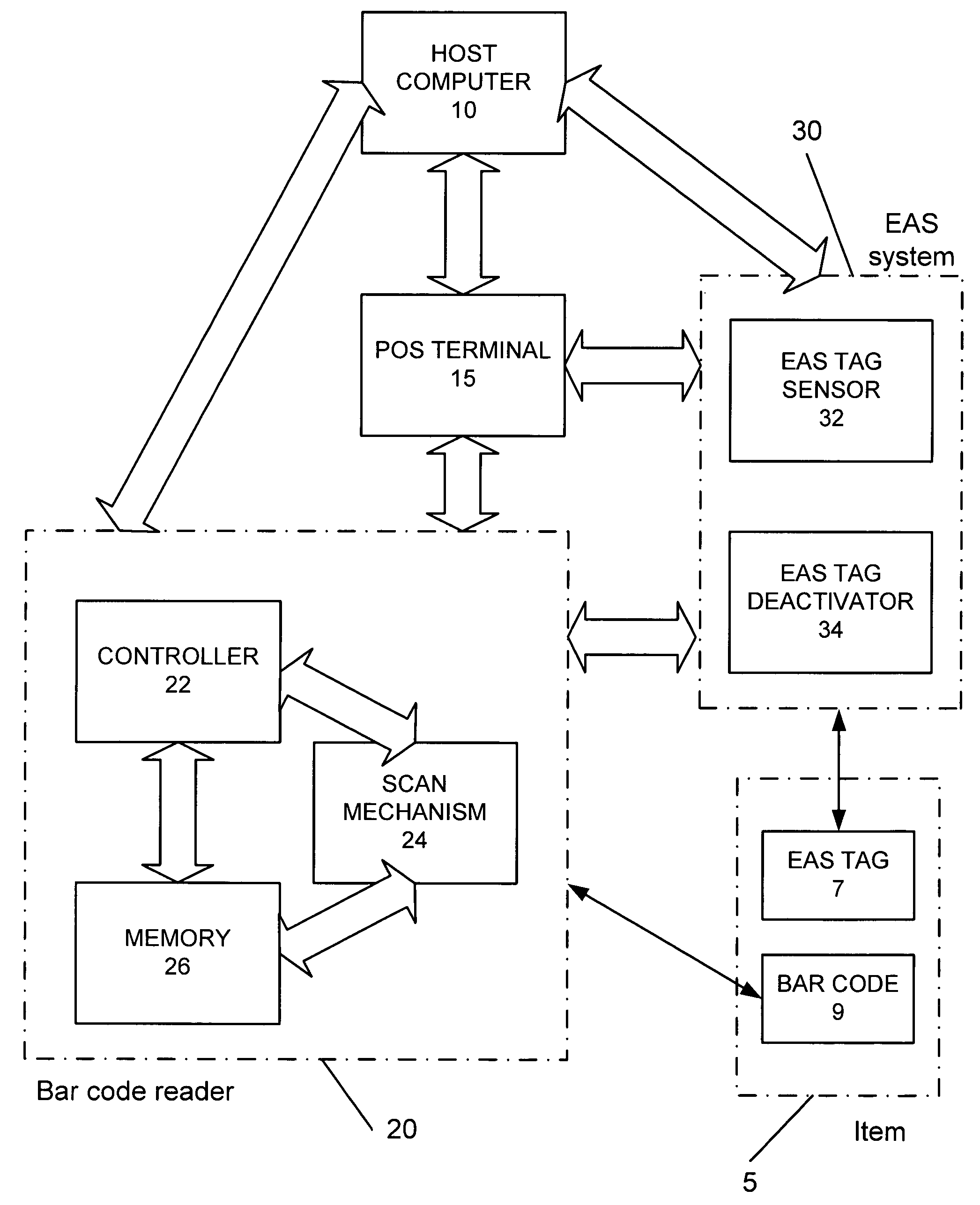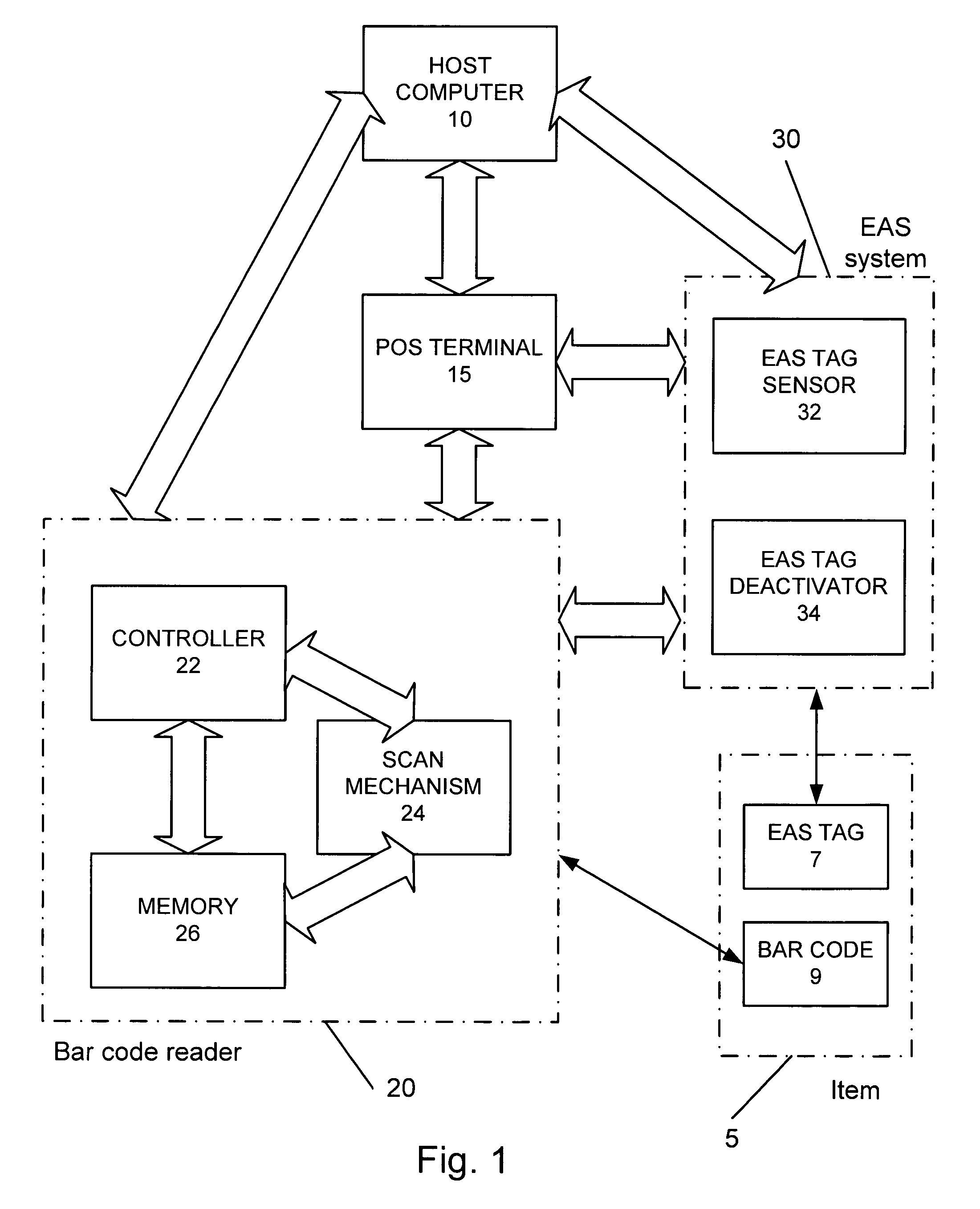Operation monitoring and enhanced host communications in systems employing electronic article surveillance and RFID tags
a technology of electronic article surveillance and host communication, applied in the direction of burglar alarm mechanical actuation, instrumentation, electromagnetic radiation sensing, etc., can solve the problems of false alarming of the eas system which is undesirable, poor quality or damage of the tag, and improper use of the eas
- Summary
- Abstract
- Description
- Claims
- Application Information
AI Technical Summary
Benefits of technology
Problems solved by technology
Method used
Image
Examples
first embodiment
[0035]FIG. 2 is a flow chart of a method as described in the following steps.[0036]Activating the system at start step 50.[0037]Commencing reading a barcode entering the scan volume at step 52.[0038]Determining at step 54 whether a good read of the barcode has been obtained; if “No” continue scanning at step 52 and if “Yes” proceed to step 56.[0039]Starting timer at step 56.[0040]Attempting to detect an EAS tag at step 58.[0041]Determining at step 60 whether an EAS tag has been detected within a time limit. If no tag is detected, it is queried at step 64 whether the time limit has expired: if “No” (time limit has not expired) continue detecting at step 58; if “Yes” (time limit has expired) proceeding to step 66. If an EAS tag is detected at step 60, proceed to step 62.[0042]At step 62, energizing the deactivation unit to deactivate the tag.[0043]Stopping the timer at step 66.[0044]At step 68, sending the operative information to the POS or host computer.
[0045]In a first instance, t...
second embodiment
[0049]FIG. 3 is a flow chart of a method as described in the following steps.[0050]Activating the system at start step 150.[0051]Commencing reading a barcode entering the scan volume at step 152.[0052]Determining at step 154 whether a good read of the bar code has been obtained; if “No” continue scanning at step 152 and if “Yes” proceed to step 156.[0053]Starting timer #1 at step 156.[0054]Attempting to detect an EAS tag at step 158.[0055]Determining at step 160 whether an EAS tag has been detected within a time limit. If no tag is detected, it is queried at step 164 whether the time limit has expired: if “No” (time limit has not expired) continue detecting at step 158; if “Yes” (time limit has expired) proceeding to step 166 stopping timer #1 and then proceeding to step 178. If an EAS tag is detected at step 160, proceed to step 162.[0056]At step 162, stopping timer #1 and starting timer #2 and then proceeding to step 168.[0057]Energizing the deactivation unit to deactivate the ta...
third embodiment
[0063]In some systems, the data reader and the EAS system are not integrated or connected to the extent as presumed by the methods of FIGS. 2 and 3. FIG. 4 is a flow chart for a third embodiment where the data reader and the EAS system are not integrated but merely communicate with each other, by the following steps.[0064]Activating the system at start step 200. Scanning and EAS detection proceed at the same time along parallel / separate paths.
In the scanner path:[0065]Commencing reading a barcode entering the scan volume at step 202.[0066]Determining at step 204 whether a good read of the bar code has been obtained; if “No” continue scanning at step 202 and if “Yes” proceed to step 206.[0067]Starting timer at step 206; and at step 214 sending an arming signal to the EAS system; then proceeding to step 208.[0068]At the same time as scanning occurs, the EAS system receives the start signal and attempts to detect an EAS tag at step 220.[0069]Determining at step 222 whether an EAS tag h...
PUM
 Login to View More
Login to View More Abstract
Description
Claims
Application Information
 Login to View More
Login to View More - R&D
- Intellectual Property
- Life Sciences
- Materials
- Tech Scout
- Unparalleled Data Quality
- Higher Quality Content
- 60% Fewer Hallucinations
Browse by: Latest US Patents, China's latest patents, Technical Efficacy Thesaurus, Application Domain, Technology Topic, Popular Technical Reports.
© 2025 PatSnap. All rights reserved.Legal|Privacy policy|Modern Slavery Act Transparency Statement|Sitemap|About US| Contact US: help@patsnap.com



